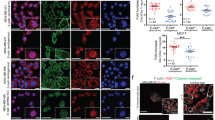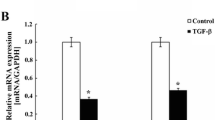Abstract
E-cadherin is a transmembrane glycoprotein which mediates epithelial cell-to-cell adhesion function as a tumor suppressor and frequently loss of expression in a wide spectrum of human cancer. However, recent studies demonstrated that E-cadherin was always over-expressed in inflammatory breast cancer (IBC) specimen and cell lines, which is a clinical extreme malignancy of breast cancer. It is hypothesized that the gain and not the loss of the E-cadherin axis contributes to the IBC unique phenotype. To test this assumption, we generated dominant negative mutant E-cadherin high-expression inflammatory breast cancer cells by introduced dominant negative mutant E-cadherin (H-2kd-E-cad) cDNA into human IBC SUM149 cells. Our studies demonstrated that the ability of invasion of SUM149 cells was significantly inhibited by H-2kd-E-cad via down-regulation of MMP-1 and MMP-9 expression. The underlying signal pathway of MAPK phosphorylated Erk 1/2(P44/42) in H-2kd-E-cad-transfected SUM149 cells was significantly down-regulated compared to parental and mock contrast. Our studies provided further functional evidence as the gain of E-cadherin expression dedicated to the IBC malignant phenotype and the blockage of MAPK/Erk activation maybe a promising therapeutic target.





Similar content being viewed by others
References
Albini A (1998) Tumor, endothelial cell invasion of basement membranes. The matrigel chemoinvasion assay as a tool for dissecting molecular mechanisms. Pathol Oncol Res 4:230–241
Alpaugh ML, Tomlinson JS, Shao ZM, Barsky SH (1999) A novel human xenograft model of inflammatory breast cancer. Cancer Res 59:5079–5084
Amagai M, Fujimori T, Masunaga T, Shimizu H, Nishikawa T, Shimizu N et al (1995) Delayed assembly of desmosomes in keratinocytes with disrupted classic-cadherin-mediated cell adhesion by a dominant negative mutant. J Invest Dermatol 104:27–32
Birchmeier W, Behrens J (1994) Cadherin expression in carcinomas: role in the formation of cell junctions and the prevention of invasiveness. Biochim Biophys Acta 1198:11–26
Braga VM (2002) Cell–cell adhesion and signalling. Curr Opin Cell Biol. 14:546–556
Bussemakers MJ, Van Bokhoven A, Tomita K, Jansen CF, Schalken JA (2000) Complex cadherin expression in human prostate cancer cells. Int J Cancer 85:446–450
Chambers AF, Matrisian LM (1997) Changing views of the role of matrix metalloproteinases in metastasis. J Natl Cancer Inst 89:1260–1270
Chang C, Werb Z (2001) The many faces of metalloproteases: cell growth, invasion, angiogenesis and metastasis. Trends Cell Biol 11:S37–43
Christofori G, Semb H (1999) The role of the cell-adhesion molecule E-cadherin as a tumour-suppressor gene. Trends Biochem Sci 24:73–76
Curran S, Murray GI (1999) Matrix metalloproteinases in tumour invasion and metastasis. J Pathol 189:300–308
Egeblad M, Werb Z (2002) New functions for the matrix metalloproteinases in cancer progression. Nat Rev Cancer 2:161–174
Frixen UH, Behrens J, Sachs M, Eberle G, Voss B, Warda A et al (1991) E-cadherin-mediated cell–cell adhesion prevents invasiveness of human carcinoma cells. J Cell Biol 113:173–185
Fukata M, Kaibuchi K (2001) Rho-family GTPases in cadherin-mediated cell–cell adhesion. Nat Rev Mol Cell Biol 2:887–897
Giroldi LA, Bringuier PP, Shimazui T, Jansen K, Schalken JA (1999) Changes in cadherin–catenin complexes in the progression of human bladder carcinoma. Int J Cancer 82:70–76
Hunt NC, Douglas-Jones AG, Jasani B, Morgan JM, Pignatelli M (1997) Loss of E-cadherin expression associated with lymph node metastases in small breast carcinomas. Virchows Arch 430:285–289
Islam S, Carey TE, Wolf GT, Wheelock MJ, Johnson KR (1996) Expression of N-cadherin by human squamous carcinoma cells induces a scattered fibroblastic phenotype with disrupted cell–cell adhesion. J Cell Biol. 135:1643–1654
Kleer CG, van Golen KL, Braun T, Merajver SD (2001) Persistent E-cadherin expression in inflammatory breast cancer. Mod Pathol 14:458–464
Levine E, Lee CH, Kintner C, Gumbiner BM (1994) Selective disruption of E-cadherin function in early xenopus embryos by a dominant negative mutant. Development 120:901–909
Nawrocki B, Polette M, Marchand V, Monteau M, Gillery P, Tournier JM et al (1997) Expression of matrix metalloproteinases and their inhibitors in human bronchopulmonary carcinomas: quantificative and morphological analyses. Int J Cancer 72:556–564
Ozawa M, Ringwald M, Kemler R (1990) Uvomorulin–catenin complex formation is regulated by a specific domain in the cytoplasmic region of the cell adhesion molecule. Proc Natl Acad Sci USA 87:4246–450
Park CH, Lee MJ, Ahn J, Kim S, Kim HH, Kim KH et al (2004) Heat shock-induced matrix metalloproteinase (MMP)-1 and MMP-3 are mediated through ERK and JNK activation and via an autocrine interleukin-6 loop. J Invest Dermatol 123:1012–1019
Pishvaian MJ, Feltes CM, Thompson P, Bussemakers MJ, Schalken JA, Byers SW (1999) Cadherin-11 is expressed in invasive breast cancer cell lines. Cancer Res 59:947–952
Shao ZM, Nguyen M, Alpaugh ML, O’Connell JT, Barsky SH (1998) The human myoepithelial cell exerts antiproliferative effects on breast carcinoma cells characterized by p21WAF1/CIP1 induction, G2/M arrest, and apoptosis. Exp Cell Res 241:394–403
Shibata T, Ochiai A, Gotoh M, Machinami R, Hirohashi S (1996) Simultaneous expression of cadherin-11 in signet-ring cell carcinoma and stromal cells of diffuse-type gastric cancer. Cancer Lett 99:147–153
Siitonen SM, Kononen JT, Helin HJ, Rantala IS, Holli KA, Isola JJ (1996) Reduced E-cadherin expression is associated with invasiveness and unfavorable prognosis in breast cancer. Am J Clin Pathol 105:394–402
Sternlicht MD, Werb Z (2001) How matrix metalloproteinases regulate cell behavior. Annu Rev Cell Dev Biol 17:463–516
Takeichi M (1993) Cadherins in cancer: implications for invasion and metastasis. Curr Opin Cell Biol 5:806–811
Takeichi M (1988) The cadherins: cell–cell adhesion molecules controlling animal morphogenesis. Development 102:639–655
Tlsty TD (1998) Cell-adhesion-dependent influences on genomic instability and carcinogenesis. Curr Opin Cell Biol 10:647–653
Tomita K, van Bokhoven A, van Leenders GJ, Ruijter ET, Jansen CF, Bussemakers MJ, Schalken JA (2000) Cadherin switching in human prostate cancer progression. Cancer Res 60:3650–3654
Tomlinson JS, Alpaugh ML, Barsky SH (2001) An intact overexpressed E-cadherin/alpha,beta–catenin axis characterizes the lymphovascular emboli of inflammatory breast carcinoma. Cancer Res 61:5231–5241
van Golen KL, Davies S, Wu ZF, Wang Y, Bucana CD, Root H et al (1999) A novel putative low-affinity insulin-like growth factor-binding protein, LIBC (lost in inflammatory breast cancer), and RhoC GTPase correlate with the inflammatory breast cancer phenotype. Clin Cancer Res. 5:2511–219
Vizirianakis IS, Chen YQ, Kantak SS, Tsiftsoglou AS, Kramer RH (2002) Dominant-negative E-cadherin alters adhesion and reverses contact inhibition of growth in breast carcinoma cells. Int J Oncol 21:135–144
Vleminckx K, Vakaet L Jr, Mareel M, Fiers W, van Roy F (1991) Genetic manipulation of E-cadherin expression by epithelial tumor cells reveals an invasion suppressor role. Cell 66:107–119
Yao J, Xiong S, Klos K, Nguyen N, Grijalva R, Li P et al (2001) Multiple signaling pathways involved in activation of matrix metalloproteinase-9 (MMP-9) by heregulin-beta1 in human breast cancer cells. Oncogene 20:8066–8074
Yap AS (1998) The morphogenetic role of cadherin cell adhesion molecules in human cancer: a thematic review. Cancer Invest 16:252–261
Zhu AJ, Watt FM (1996) Expression of a dominant negative cadherin mutant inhibits proliferation and stimulates terminal differentiation of human epidermal keratinocytes. J Cell Sci 109(Pt 13):3013–3023
Acknowledgments
We thank Dr. Ioannis S. Vizirianakis and Professor Stephen P. Ethier for the plasmid pcDNA3.1(-)Myc/His and the SUM149 cell line This research was supported in part by grants from the Outstanding Young Investigator Award of National Natural Science Foundation of China (No. 30025015), National Natural Science Foundation of China (30371580) and National Key Project of China (No. 2001BA703BO5), and the Grant from Shanghai Science and Technology Committee (03J14019).
Author information
Authors and Affiliations
Corresponding author
Additional information
Hui-Ming Dong and Gang Liu contributed equally to this work.
Rights and permissions
About this article
Cite this article
Dong, HM., Liu, G., Hou, YF. et al. Dominant-negative E-cadherin inhibits the invasiveness of inflammatory breast cancer cells in vitro. J Cancer Res Clin Oncol 133, 83–92 (2007). https://doi.org/10.1007/s00432-006-0140-6
Received:
Accepted:
Published:
Issue Date:
DOI: https://doi.org/10.1007/s00432-006-0140-6




